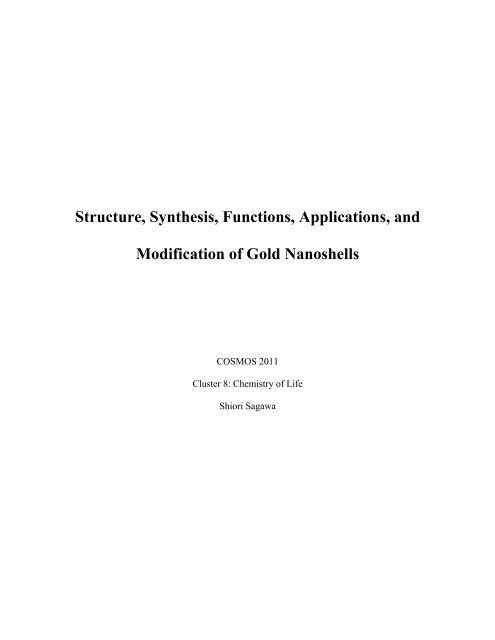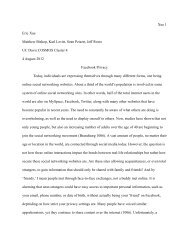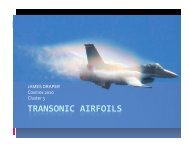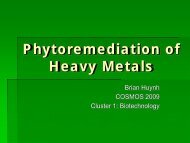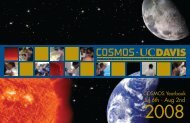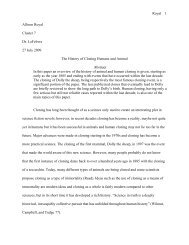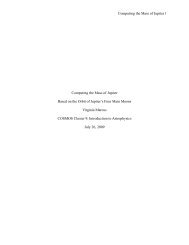sagawa, shiori - COSMOS
sagawa, shiori - COSMOS
sagawa, shiori - COSMOS
You also want an ePaper? Increase the reach of your titles
YUMPU automatically turns print PDFs into web optimized ePapers that Google loves.
Structure, Synthesis, Functions, Applications, and<br />
Modification of Gold Nanoshells<br />
<strong>COSMOS</strong> 2011<br />
Cluster 8: Chemistry of Life<br />
Shiori Sagawa
Abstract<br />
Gold nanoshells are dielectric cores surrounded by thin gold layers. They are well known<br />
for their unique optical properties, explained by plasmon hybridization theory as well as quantum<br />
mechanics calculations. Their optical attributes are applied in a variety of aspects, including<br />
visual enhancement and cancer therapy. Not only can they can absorb and scatter light of great<br />
intensities, but the wavelengths absorbed and scattered by gold nanoshells range extensively<br />
from visible to far infrared. Furthermore, the scattered light can have controlled wavelengths.<br />
Among many applications, this paper focuses on the use of nanoshells in cancer diagnosis and<br />
therapy, including imaging enhancement for early detection, photo-thermal ablation, and<br />
inhibition of pro-angiogenic growth factor. In addition to properties and applications of gold<br />
nanoshells, their structure, synthesis, and modification using gold-copper-64 alloys are<br />
explained.<br />
Background<br />
Gold nanoshells, varying from 30nm to 120nm in diameter (Rasch, 2009), are<br />
dielectric cores surrounded by thin, uniform layers of gold, giving rise to concentric spheres<br />
(Brinson, 2008). As it can be inferred from their name, nanoshells are classified as a type of<br />
nanomaterial because they are usually less than 100nm in diameter and their optical properties,<br />
which they are mostly known for, arise from their nano-scale size.<br />
Traditionally, gold nanoshells are assembled in the following process. To begin<br />
with, oxide nanoparticles, such as silica, are functionalized with aminopropyltriethoxy or<br />
methoxysilane to attach gold particles to the surface. After functionalization, gold nanoparticles<br />
are bound to the surface. This is followed by reduction of Au 3+ (aq) → Au 0 (s) on the surface of the
nanoparticle. This process allows gold particles to merge and create a thin layer, giving rise to a<br />
complete nanoshell structure (Brinson, 2008).<br />
As previously stated, gold nanoshells have unique optical properties. Gold<br />
nanoshells have the ability to absorb and scatter a great quantity of light in a relatively wide<br />
range, varying from visible to far infrared (Brinson, 2008). The wavelength of the light can also<br />
be controlled by modifying the layer to core ratio (Brinson, 2008), making the nanoshells very<br />
practical. Although this optical attribute has been confirmed with quantum mechanics<br />
calculations as shown in the study by E. Prodan and P. Nordlander (Prodan and Nordlander,<br />
2003), the concept can also be explained by the plasmon hybridization model. In gold<br />
nanoshells, both gold layers and cores exhibit plasmonic properties (Prodan, 2003), indicating<br />
that they have oscillating electron clouds. Since each component contains plasmons and is close<br />
to each other, plasmons interact (Prodan, 2003). As they interact, or “hybridize,” they produce 2<br />
resonances (Prodan, 2003) shown in the picture below.<br />
(Prodan, 2003)<br />
The two resonances are symmetric or bonding plasmon, denoted as ω– in the picture above,<br />
which is a lower energy state that responds strongly to incident light, and asymmetric or
antibonding plasmon, denoted as ω+ in the picture above, which is a higher energy state that<br />
responds weakly to incident light (Prodan, 2003). Absorption and scattering of light causes<br />
change in energy, which is exhibited as change in the state. Since layer-core ratio determines<br />
how well plasmons interact, it determines the energy states of plasmonic resonances. Thus, the<br />
wavelength of the absorbed and scattered light depends on the layer-core ratio, making gold<br />
nanoshells tunable with respect to the relative sizes of the core and layer.<br />
This unique feature of gold nanoshells is exploited in numerous applications, including<br />
those in cancer therapy. One application is cancer imaging. With current methods, which involve<br />
reflectance-based techniques, it is very difficult to detect early forms of cancer due to unclear<br />
images caused by insufficient reflection by cancer cells (NCLT, 2008). To cope with this<br />
weakness, gold nanoshells can be used as markers to enhance images. First, gold nanoshells are<br />
attached specifically to cancer cells. This is achieved by attaching structures that bind to proteins<br />
that are over-expressed in cancer cells, such as HER2 in breast cancer (NCLT, 2008). Then,<br />
nanoshells scatter light, which is processed to derive the depth of the cancer tissue (NCLT,<br />
2008). Since nanoshells scatter light of greater intensity compared to cancer cells, the image is<br />
enhanced (NCLT, 2008). The small size of nanoshells in comparison to cancer tissues allows<br />
them to accurately express the size and shape of cancer cells (NCLT, 2008). Furthermore, they<br />
can achieve high quality images because a very large number of them cover the cancer tissue<br />
(NCLT, 2008). Their tunable property also allows one to shine light of specific wavelength, near<br />
infrared, which causes no harm to the human body (NCLT, 2008). This technique allows for<br />
clearer images, leading to early detection of cancer, which is very significant for effective<br />
treatment.
Another method in which the optical properties of gold nanoshells can be used in cancer<br />
therapy is photo-thermal ablation, a process in which gold nanoshells bound to cancer cells are<br />
used to turn laser into a significant quantity of heat, killing cancer cells (Lal, 2008). First, gold<br />
nanoshells are dispatched specifically to cancer cells. This can be achieved by the process<br />
described in the paragraph above or by only injecting nanoshells into the blood stream since new<br />
blood vessels created by cancer cells are abnormal with large gaps, enhancing permeability and<br />
retention, which eventually brings a great majority of nanoshells to cancer cells (Lal, 2008).<br />
Next, near infrared light with wavelengths of 700nm to 1100 nm are directed to the area of<br />
treatment (Lal, 2008). Near infrared light is most effective because it minimizes water absorption<br />
and is most transmissive with respect to blood and tissue (Lal, 2008). When the light passes<br />
through gold nanoshells, it causes plasmon resonance, in which nanoshells get excited and gain<br />
energy. Since electrons prefer to be at a lower energy level, nanoshells release the gained energy<br />
as heat, causing the temperature of a cancer cell to increase (NCLT, 2008). Within 4 to 6 minutes<br />
of exposure to laser, 37.4 ± 6.6 °C increase, sufficient to ablate cancer cells, was observed (Lal,<br />
2008), confirming efficiency.<br />
The effectiveness of the photo-thermal ablation using nanoshells was shown by the study<br />
of Surbhi Lal, Susan E. Clare, and Naomi J. Halas. In the study, mice were given one of the three<br />
treatments: laser followed by gold nanoshells injection, laser followed by saline injection, and no<br />
treatment (Lal, 2008). The results are shown in the figure below:
(Lal, 2008)<br />
As shown above, there was a significant difference in tumor size; complete ablation was<br />
observed in the treatment group while growth was observed on other groups (Lal, 2008). A<br />
significant difference was observed in the survival rate as well (Lal, 2008), proving the<br />
effectiveness of photo-thermal ablation. 100% survival rate in the treatment group (Lal, 2008)<br />
also signifies that the treatment does not have immediate lethal side effects, showing that healthy<br />
tissues are not lethally damaged.<br />
Another property of gold nanoshells is the inhibition of pro-angiogenic growth factor,<br />
also known as VEGF165, which causes abnormal growth, migration, and survival of cancer cells<br />
(Patra, 2010). This property was exhibited experimentally; pro-angiogenic growth factor-induced
proliferation of human umbilical vein endothelial cells was inhibited in the presence of gold<br />
nanoshells with FeCo cores. No inhibition was observed in VEGF165-induced growth in the<br />
absence of gold nanoshells as well as in the non-VEGF165-induced growth in the presence of<br />
gold nanoshells, which also indicated the non-toxicity of FeCo core gold nanoshells (Patra,<br />
2010). Using this property, nanoshells can be used as an improved replacement for the toxic antiangiogenic<br />
agents used today to halt the growth, migration, and survival of cancer cells (Patra,<br />
2010).<br />
Purpose<br />
The purpose of the modification is to create improved nanoshells that can be used both to<br />
detect and treat cancer.<br />
Method and Discussion<br />
In order to create improved nanoshells with applications in both diagnosis and therapy in<br />
cancer, an alloy of gold and copper-64 is used as an outer layer, replacing pure gold. Copper-64<br />
is a radioactive element, decaying via positron emission with a half-life of approximately 12.7<br />
hours (Starkewolf, 2011). The radioactivity along with its plasmonic property allow this device<br />
alone to conduct high-quality imaging as well as photo-thermal ablation.<br />
Although gold-copper-64 nanoparticles do not currently exist, gold-copper nanoparticles<br />
have been synthesized in many studies, including the study by Motl and co-workers (Motl,<br />
2010). The synthesis involved a combination of HAuCl 4·3H 2 O and Cu(acac) 2 (Motl, 2010), so<br />
synthesis of gold-copper-64 nanoparticles can be achieved by using Cu(acac) 2 with copper-64<br />
when synthesizing nanoparticles. Then, using those gold-copper nanoparticles, nanoshells can be
synthesized using a process similar to that of gold nanoshells, which involves functionalization<br />
of the shell, binding of nanoparticles, and reduction to merge the nanoparticles into a single layer<br />
(Brinson, 2008).<br />
Because copper-64 is a positron emitting radionuclide, the modified nanoshells can be<br />
used as tracers in an imaging technique called positron emission tomography or PET<br />
(Starkewolf, 2011), which creates images based on gamma rays produced in positron emitting<br />
radionuclides (Pieterman, 2010). Nanoshells would be designed specifically to target the<br />
cancerous cells by allowing nanoshells to bind to overly-expressed proteins in cancer tissues<br />
(Pieterman, 2010). Since copper-64 has relatively short half-life and is a positron emitting<br />
radionuclide (Starkewolf, 2011), PET can detect the gamma ray, creating images (Pieterman,<br />
2010). PET can produce one of the highest resolution images today, which would allow for<br />
earlier detection of cancer (Pieterman, 2010).<br />
In addition to the radioactivity, plasmonic property is likely to be retained by goldcopper-64<br />
nanoshells. First, both gold and copper are plasmonic elements (Motl, 2010). Since<br />
alloys often retain the properties of pure metals, it is anticipated that the alloy would be<br />
plasmonic as well. Secondly, in the study by Motl and co-workers, gold-copper nanoparticles<br />
retained plasmonic properties (Motl, 2010), suggesting a high likelihood of the retention of the<br />
property in nanoshells. Also observed in the study was a shift in the spectrum of light absorbed<br />
and scattered toward lower energies (Motl, 2010). Even though the shift is highly probable in<br />
nanoshells, a drastic effect is not expected since the shift in nanoparticles only consisted of<br />
100nm or<br />
in proportion (Motl, 2010), suggesting that it is likely that nanoshells can still be<br />
tuned to near infrared, the least harmful and most effective type of light for cancer therapy. Thus,<br />
it is expected that the shift would not be an issue. Although experiments are required to affirm
the retention as well as lack of drastic shift, the optical properties would allow gold-copper-64<br />
nanoshells to be used in cancer therapy through photo-thermal ablation.<br />
As discussed previously, the use of gold-copper-64 nanoshells would allow for the<br />
execution of both cancer detection and therapy with one device, increasing efficiency. First,<br />
nanoshells are dispatched specifically to cancer cells. Then, using PET, a high-quality image of<br />
cancer cells can be obtained, allowing for an early diagnosis. Then, after imaging, lasers can be<br />
applied to the area of interest so that nanoshells, which were used as PET tracers, can now be<br />
used to practice photo-thermal ablation of cancer cells.<br />
Conclusion<br />
With early detection through enhanced imaging, photo-thermal ablation, and inhibition of<br />
pro-angiogenic growth factor, gold nanoshells have great possibilities for cancer diagnosis and<br />
therapy. In order to improve the efficiency and quality of the process, gold-copper-64 alloy was<br />
used as a replacement for the gold outer layer, adding radioactivity while keeping the plasmonic<br />
properties. The modification allows a single type of nanoparticle to achieve diagnosis as well as<br />
therapy since gold-copper-64 nanoshell can be used in PET and photo-thermal ablation.<br />
However, experiments are required to confirm the radioactivity and optical properties of goldcopper-64<br />
nanoshells.<br />
Bibliography<br />
Brinson, B. E., et al. 2008. Nanoshells made easy: improving au layer growth on nanoparticle<br />
surfaces. Langmuir, 24(24), Accessed<br />
2011 Aug 1.
Lal, S. 2008. Nanoshell-enabled photothermal cancer therapy: impending clinical impact.<br />
Accounts of Chemical Research, 41(12),<br />
Accessed 2011 Aug 1.<br />
Motl, N. E., et al. 2010. Au−Cu alloy nanoparticles with tunable compositions and plasmonic<br />
properties: experimental determination of composition and correlation with theory.<br />
Journal of Physical Chemistry, 114(45). <br />
Accessed 2011 Aug 2.<br />
NCLT. 2008, March 2. Nanomedicine-gold nanoshells.<br />
<br />
Accessed 2011 Aug 3.<br />
Patra, C. R. 2010. A core-shell nanomaterial with endogenous therapeutic and diagnostic<br />
functions. Cancer Nanotechnology, 1(1).<br />
Accessed 2011 Aug 1.<br />
Pieterman, R. M., et al. 2010. Preoperative staging of non-small-cell lung cancer with positronemission<br />
tomography. The New England Journal of Medicine. 343(4).<br />
<br />
Prodan, E. and Nordlander, P. 2003. Structural tunability of the plasmon resonances in metallic<br />
nanoshells. Nano Letters,3(4). <br />
Accessed 2011 Aug 1.<br />
Prodan, E., et al. 2003. A hybridization model for the plasmon response of complex<br />
nanostructures.Science, 302(5644).<br />
Accessed 2011 Aug 1.<br />
Rasch, M. R., et al. 2009. Limitations on the optical tunability of small diameter gold<br />
nanoshells.Langmuir, 25(19).<br />
Accessed 2011 Aug 1.<br />
Starkewolf, Z. 2011 Aug 4. Personal Interview.


